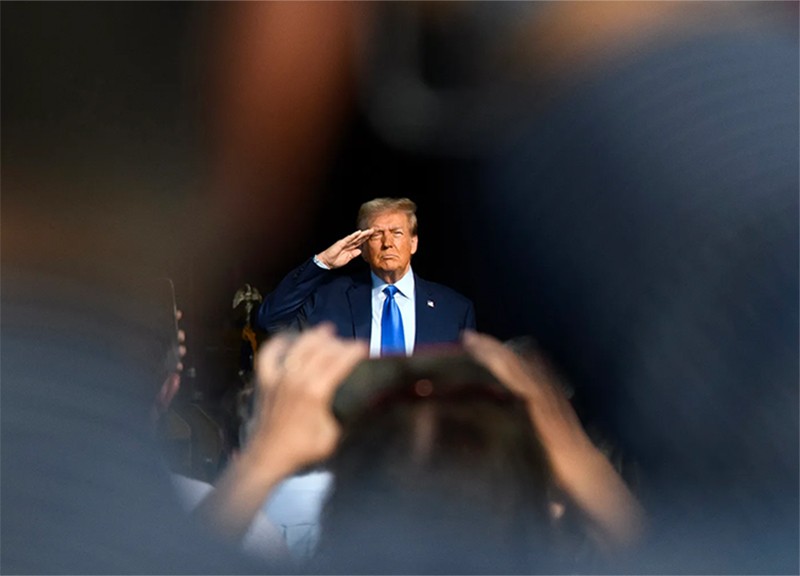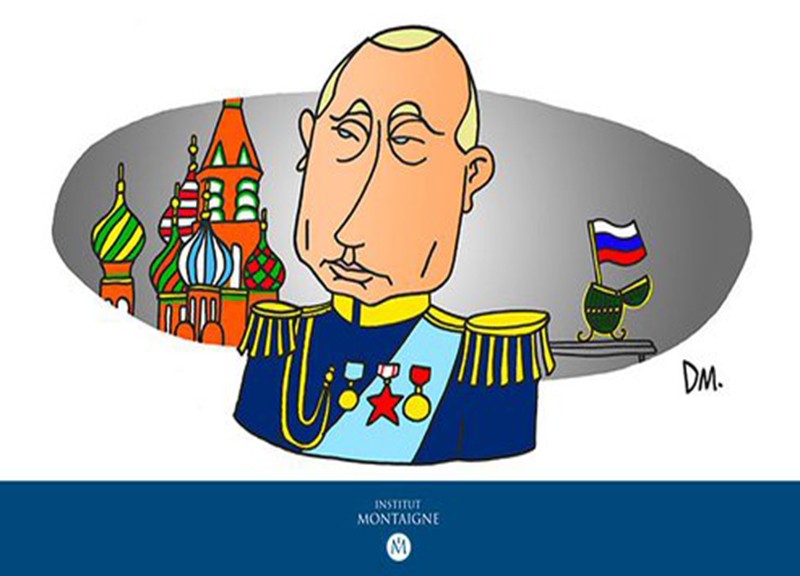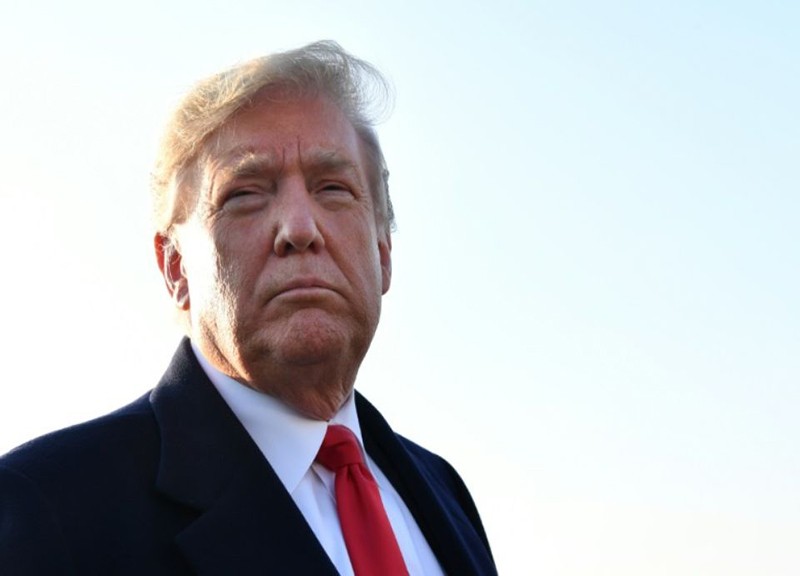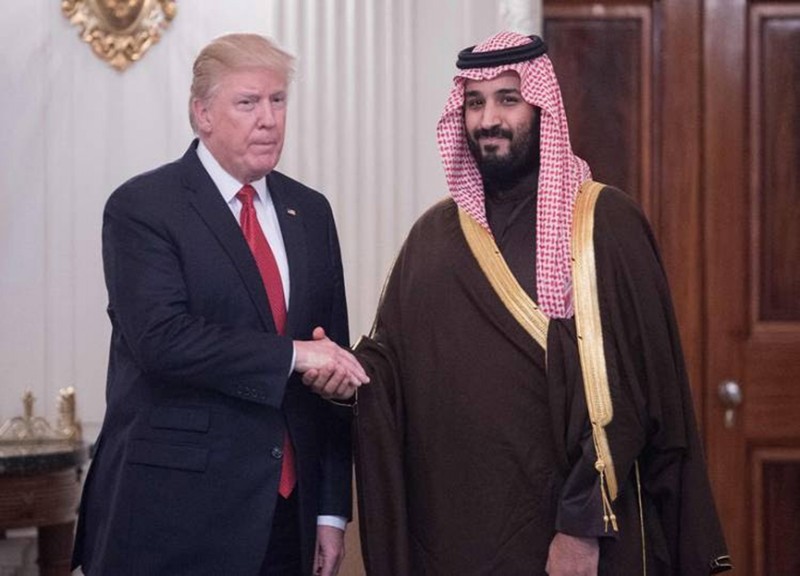
Dramatic global shifts since Donald Trump’s first term could lead to unexpected policies.
By Gabriel Scheinmann, the executive director of the Alexander Hamilton Society. Foreign Policy
What would Donald Trump’s foreign policy look like, should he win a second presidential term? The debate ranges between those who believe he will abandon Ukraine, withdraw from NATO, and herald a “post-American Europe”—and those who predict he will escalate the Russian-Ukrainian war and continue his fiercely anti-communist policies. Foreign governments have been frantically reaching out to Trump and Republican circles to understand, if not influence, the future direction of his policies; one such visit may have even played a role in Trump’s acquiescence to the most recent batch of U.S. military aid to Ukraine following months of delay by many of his Republican supporters in the U.S. Congress.
One fact is already clear: If Trump regains the presidency, he and his potential advisors will return to a significantly changed global landscape—marked by two regional wars, the threat of a third in Asia, the return of great-power geopolitics, and globalization measurably in decline. While many expect a Trump 2.0 to be a more intense version of Trump 1.0, his response to the dramatic changes in the geopolitical environment could lead to unexpected outcomes.
Trump may now be less eager to abandon Europe given fast-rising European defense spending and an ongoing major war. The strengthening U.S. economy and flux in global supply chains could facilitate a broader decoupling from China and market-access agreements with allies. Expanded Iranian aggression could make it easier for Trump 2.0 to build a large international coalition. An examination of these and other changes of the last four years could yield surprising insights into how a second Trump administration could differ significantly from the first.
Asylum-seekers rush to be processed by Border Patrol agents at an improvised camp near the U.S. border with Mexico in eastern Jacumba, California, on Feb. 2.Guillermo Arias/AFP via Getty Images
Since Trump left office, the U.S.-Mexico border crisis has worsened significantly. In 2020, Trump’s last full year in office, U.S. Customs and Border Protection carried out 646,822 enforcement actions, including against three individuals on the Terrorist Screening Data Set. By 2023, this had skyrocketed to 3.2 million encounters, including 172 people on the terrorist list. Under the Biden-Harris administration, there have been some 10 million illegal border crossings, including nearly 2 million known so-called gotaways—illegal crossers who could not be apprehended. The unsecured border, broken asylum process, and overwhelmed immigration courts have enabled significant fentanyl trafficking, resulting in over 200,000 American deaths in the last three years.
For a second Trump administration, sealing the border would be the critical national security issue, overshadowing all others. The Republican platform calls for completion of the border wall, the use of advanced technology on the border, and shifting the focus of federal law enforcement to migration. It also proposes redeploying troops from overseas to the southern border and deploying the U.S. Navy to impose a fentanyl blockade. Americans now see the border as a major problem, and Congress is likely to support significant spending. This reallocation will impact other areas, since the U.S. Army and Navy are already struggling with personnel and fleet size targets. Navigating tensions with Mexico and Central American countries, many of which have free-trade agreements with the United States and receive U.S. assistance, will be challenging.
Facing escalating regional wars and the smallest U.S. military in generations, Trump would likely oversee the most significant U.S. military buildup in nearly 50 years. The U.S. Armed Forces are shrinking, and the defense budget is close to its post-World War II low in terms of both federal budget share and percentage of GDP. The capacity, capabilities, and readiness of the U.S. military are weakening, and the defense industrial base has atrophied. The disastrous defeat in Afghanistan has led to a significant drop in Americans’ confidence in the military.
Then-President Trump joins Naval Academy cadets during the Army v. Navy American football game in Philadelphia on Dec. 14, 2019.Andrew Caballero-Reynolds/AFP via Getty Images
Trump has long supported a bigger and stronger military, but his administration’s modest budget increases primarily went to personnel, operations, and maintenance, with little investment in capabilities. Under then-Defense Secretary James Mattis, the 2018 National Defense Strategy abandoned the long-standing U.S. doctrine of maintaining readiness to fight wars in two regions simultaneously, focusing instead on deterring China in the Indo-Pacific. Today’s Trump-approved Republican platform pledges a larger, modern military, investment in the defense industrial base, and a national missile defense shield. Republican Sen. Roger Wicker, likely the next chair of the Senate Armed Services Committee, has proposed a detailed plan to raise defense spending from 3 percent of GDP in 2024 to 5 percent within five to seven years. This plan aligns with Trump’s policies and could lead to a domestic manufacturing boom. Trump could announce the first-ever trillion-dollar defense budget with broad Republican support, determined not to be remembered as the president who let China surpass the U.S. militarily.
Notwithstanding the Biden administration’s climate agenda, the United States’ historic rise as the world’s energy superpower could empower Trump to pursue more punitive policies against Russia and Iran while wielding greater leverage over China. The United States is now producing and exporting more energy than ever, even as its carbon emissions have decreased, largely due to the shift from coal to gas. In 2019, the country became a net energy exporter. Since 2017, total energy exports have nearly doubled, and the country has surpassed Russia and Saudi Arabia to become the world’s biggest oil producer. By further ramping up liquefied natural gas exports to Europe, a second Trump administration could reduce Russia’s influence, reshape European geopolitics, and strengthen trans-Atlantic ties. It would also greatly reduce the trade deficit with Europe, something Trump frequently rails about. Expanding energy production would also increase U.S. leverage over China, the world’s largest energy importer. Greater production—as well as closer alignment with Saudi Arabia under Trump—could do much to lower gas prices in the United States and oil prices globally. This, in turn, would allow Trump to pursue more aggressive strategic policies, such as striking Iranian nuclear assets or, should he wish to do so, diminishing Russian oil and gas exports.
The relative strength of the U.S. economy and major shifts in trading patterns would give another Trump administration far greater leverage on trade—including winning a trade war with China and striking new or revised trade deals with others.
Many Americans have a pessimistic view of their country’s economy, but it is far stronger relative to its peers than in 2016 or 2020. This year, the U.S. economy will account for an estimated 26 percent of global GDP, the highest share in almost two decades. It was nearly four times the size of Japan’s when Trump first entered office, and it will be seven times as large by the end of this year. As recently as 2008, the U.S. and Eurozone economies were similar in size. Today, the former towers over the latter, with the U.S. economy almost 80 percent larger. Britain’s relative decline is similar.
The strength of the U.S. economy would give Trump the leverage to strike the fair and reciprocal trade deals he seeks. Japan, facing an ever-aggressive China and urgently needing to boost economic growth, might build on the 2019 U.S.-Japan market access deal. Trump could resume the talks with Britain from the end of his first term with more leverage; a former Trump official indicated that a deal with Britain would be a priority in a second term. Trump might also revisit negotiations with the EU, following up on a market access agreement signed in 2019 following his imposition of tariffs. After eight years on top, the United States has overtaken China to be Germany’s top trading partner again. Trump’s aim to secure better deals is evident, and he may find more willing partners than before.
An employee works at a wind turbine manufacturing factory.
An employee works at a wind turbine manufacturing factory in Qingzhou, China, on March 18.China OUT/AFP via Getty Images
The same dynamics may lead to a far broader trade war with and decoupling from China. The U.S. economy has grown relative to China’s over the past eight years, with the gap widening in both directions: The U.S. economy is larger and the Chinese one smaller than economists expected. The forecast for when China’s economy might surpass the United States’ keeps sliding further and further into the future and may never happen at all. The International Monetary Fund projects that China’s share of the Asia-Pacific region’s GDP will be slightly smaller in five years than it is today, and it may never become the majority share. Even China’s official, flattering statistics suggest its economy is experiencing a lost decade due to deeply structural challenges, not temporary ones.
Over the past eight years, the U.S. economy has also become less dependent on foreign trade, including with China. In 2016, China was the top U.S. trading partner, accounting for more than 20 percent of U.S. imports and about 16 percent of total U.S. trade. By 2023, China slipped to third place, accounting for 13.9 percent of imports and 11.3 percent of trade. This shift would give greater credibility to Trump’s threats to revoke China’s most-favored nation trading status and impose wide-ranging tariffs. While these measures would have economic costs for Americans, around 80 percent of Americans view China unfavorably today, a significant increase from 2017, and the United States is now better positioned to withstand a protracted trade war with China than a few years ago.
Then-President Trump takes his mask off before speaking from the White House during a rally in Washington, D.C., on Oct. 10, 2020.Mandel Ngan/AFP via Getty Images
Trump 2.0 would have the potential to lead a broader containment approach toward China. First, Trump and most Americans blame the Chinese government for the COVID-19 pandemic, which killed more than 1 million Americans, forced the U.S. economy into a deep recession, and likely cost Trump his reelection in 2020. Whether through trade measures, sanctions, or a demand for reparations, Trump will seek to hold China accountable for the estimated $18 trillion in damage the COVID-19 pandemic caused to the United States. In parallel, he is likely to end the attempts at partnership made by the Biden administration and Trump during parts of his first term. Issues like climate change, public health, foreign investment, Chinese land purchases in the United States, and Beijing’s role in the fentanyl epidemic will be viewed through the lens of strategic independence from China, as outlined in the Republican platform.
Second, the United States’ major European allies have become much more critical of China than when Trump left office—the result of COVID-19, Chinese “wolf warrior” diplomacy, Beijing’s support for Moscow’s war in Ukraine, and mounting issues concerning trade, technology, and supply chains. The references to China in the 2024 G-7 summit statement and NATO summit communique, compared to the last versions under Trump in 2019, make that clear. Europe is following Washington’s lead in imposing tariffs on Chinese electric vehicles, restricting Chinese telecoms from 5G infrastructure, and exposing and punishing Chinese espionage. A second Trump administration could build a coalition against Chinese behavior.
Third, the United States’ Asian allies are enhancing their military capabilities and cooperation among themselves. Australia, Japan, South Korea, Taiwan, and others are increasing their defense spending, and the United States recently negotiated expanded military access to key sites in the Philippines. Improved regional alliances and partnerships, including the Australia-United Kingdom-United States (AUKUS) pact, the Quad (Australia, India, Japan, and the United States), much improved Japan-South Korea relations, and growing Japan-Philippines cooperation will strengthen Trump’s hand with Beijing.
However, the China Trump will face is more powerful and aggressive than ever before. It has significantly increased its military harassment of Taiwan, the Philippines, and India. It has also deepened its strategic partnership with Russia: The two countries declared a “partnership without limits” in 2022, and Chinese President Xi Jinping told Russian President Vladimir Putin in 2023 that the world is undergoing changes “we haven’t seen for 100 years—and we are the ones driving these changes together.” China’s navy, already larger than its U.S. counterpart since around 2015, could be about 50 percent larger by the end of Trump’s second term. How would Trump respond if China attacked Taiwan? Washington assesses that Xi has ordered the Chinese People’s Liberation Army (PLA) to be prepared to win a war against Taiwan by 2027, and U.S. war games consistently indicate the U.S. could lose such a conflict. Trump continues to hew to the decadeslong policy of maintaining strategic ambiguity regarding Taiwan’s defense, even if he has included Taiwan in his familiar critique of allies not doing enough for their own defense. Nevertheless, the continuously eroding balance of power and rapidly evolving correlation of forces could make Trump less likely to assist Taiwan than one might suspect given his overall China policy. As Trump recently acknowledged in the bluntest of terms, Taiwan is 9,500 miles away from the United States but only 68 miles away from China.
Ukrainian President Volodymyr Zelensky (left) and then-President Trump shake hands during a meeting on the sidelines of the United Nations General Assembly in New York on Sept. 25, 2019. Saul Loeb/AFP via Getty Images
Trump would return as commander in chief with the largest European war since World War II raging in Ukraine, the increased presence of U.S. forces on the continent, and European NATO members ramping up their defense spending. The much-changed situation in Europe could make him far less likely to withdraw U.S. troops, end support for Ukraine, or seek a grand bargain with Putin.
Trump’s persistent haranguing of European allies when he was president, coupled with Russia’s invasion of Ukraine, has prompted European countries to rapidly increase their defense spending. Whereas only five NATO members spent at least 2 percent of GDP on defense in 2016 and nine did so in 2020, 23 do so now. European NATO nations have increased their collective defense spending by more than half since Trump first took office, far ahead of the United States’ much smaller increase during the same period. Germany has even surpassed Britain as Europe’s biggest defense spender. The burden sharing Trump pushed for is beginning to happen: European NATO allies are now shouldering a greater share of bloc-wide defense spending, and Europe also provides the majority of aid to Ukraine. U.S. companies and workers are benefiting: The U.S. share of global arms exports rose from 34 percent to 42 percent over the most recent five-year period.
In his first term, Trump welcomed both Montenegro and North Macedonia into NATO, even though neither met the 2 percent mark at the time. His inclination to move U.S. forces farther east along NATO’s frontier is now a reality. Today, 20,000 U.S. forces are stationed in the alliance’s eastern frontier states, part of what Supreme Allied Commander Europe Gen. Christopher Cavoli called a “definite shift eastward.” With the addition of Finland and Sweden as a result of Russia’s invasion of Ukraine, NATO now has a significantly reshaped posture.
While the 2 percent floor for defense spending is now grossly inadequate, European states are proposing higher benchmarks. The European Union has released its first-ever defense industrial strategy, and many European countries are planning further increases in spending. Were Trump to preside over the June 2025 NATO summit in the Netherlands, he could not only announce “mission accomplished” with respect to the 2 percent target, but that NATO has collectively pledged a higher 3 percent floor.
Trump has promised to negotiate an end to the war in Ukraine “in 24 hours”—but has also threatened to dramatically increase arms support to Ukraine if Putin does not comply. He has never outright opposed military aid to Ukraine, acquiesced to congressional passage of a large supplemental in April, and recently concluded a positive call with Ukrainian President Volodymyr Zelensky. Having observed how Biden’s disastrous withdrawal from Afghanistan sunk his presidency, Trump may be determined to avoid a similar loss of Ukraine.
Facing a Middle East with escalating Tehran-backed conflicts and a near-nuclear Iran, Trump 2.0 might also double down and increase U.S. military involvement to douse the fires Tehran has lit.
Trump is likely to end the Biden administration’s pressure on Israel to end the war against Hamas, de-escalate against Iran, and withdraw from Gaza and the West Bank. Trump would end Biden’s embargo on certain U.S. arms deliveries to Israel, halt aid to Gaza, and de-emphasize humanitarian concerns. Trump has consistently supported an Israeli “victory”—a stance repeated by his running mate, Sen. J.D. Vance—and called on Israel to “finish the job.” Trump has walked back his previous endorsement of a Palestinian state, suggesting a very different approach to the “day after.” If a major war between Israel and Hezbollah breaks out, Trump’s track record suggests he would support swift Israeli action with less concern for civilian casualties, with full U.S. support but no direct military involvement.
Trump 2.0 would quickly face the choice of whether to take preemptive military action against Iranian nuclear facilities. Iran is now a nuclear breakout state, capable of producing enough weapons-grade uranium for several bombs in less than 10 days, even if weaponization may take several months to a year. Berlin, Paris, and London, antagonists to Trump 1.0’s Iran policy, may be supporters of Trump 2.0’s, as Iran’s growing military alliance with Russia, nuclear progress, and support for the Houthis have shifted European attitudes. Having repeatedly passed the wartime tests by Iran and its proxies, Israeli anti-air capabilities have rapidly improved, as has coordination with Arab partners. Trump will likely recharge his maximum-pressure approach, but he may be more likely to threaten Iran directly than ever before.
Trump 2.0 could also launch a campaign against the Houthis similar to that against the Islamic State during Trump 1.0. He would inherit a 24-nation coalition that is currently failing to restore freedom of navigation through the Red Sea. Despite the most intense U.S. naval combat operations since World War II, Suez Canal transits are still fewer than half of what they were a year ago; so far, over 90 commercial vessels have been hit and more than 100 warships attacked. Just as he declared the defeat and destruction of the Islamic State to be his “highest priority” on the first day of his presidency, he may flip the mission from a defensive to offensive one by hitting Houthi launch sites, targeting critical infrastructure, eliminating Iranian naval support, and directly threatening Tehran. A successful campaign could restore commercial shipping, lower energy and shipping costs, and foster diplomatic cooperation with European, Middle Eastern, and Asian governments.
Even if Trump’s instincts and inclinations remain unchanged, the world’s vastly shifted circumstances could prompt unexpected approaches. If Trump 1.0 was an alliance disruptor and protectionist, a second Trump administration could turn out to be a coalition builder and forger of significant trade deals. Concerns over U.S. abandonment of Europe and withdrawal from the Middle East may prove to have been hasty, with altered circumstances leading to greater stability in Europe and a rollback of Iranian aggression in the Middle East. Dealmaking with China may give way to the best opportunity to build a Cold War-like coalition to blunt aggressive Chinese behavior.














